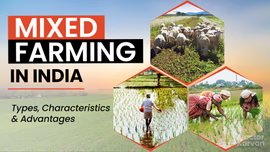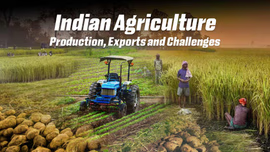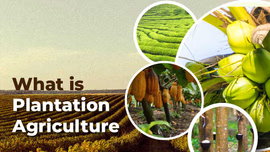Ridge and Furrow Method of Irrigation: Advantages and Disadvantages

Ridge and Furrow irrigation is a surface irrigation method that uses shallow channels (called furrows) to guide water between raised crop rows. It’s a low-cost, widely used technique that supports healthy crop growth. In this article, we’ll explore how ridge and furrow irrigation work, how it benefits farmers, and limitations. Keep reading to find out more.
Table of Contents
- What is the Ridge and Furrow Method of Irrigation?
- How Ridge and Furrow Irrigation Works?
- How to Create Ridges and Furrows for Irrigation?
- What are the Types of Ridges and Furrow Methods of Irrigation?
- What are the Advantages of Ridges and Furrow Method?
- What are the Disadvantages of the Ridge and Furrow Method?
What is the Ridge and Furrow Method of Irrigation?
Water plays an important role in farming, especially during the process of irrigation, where water is heavily utilized. To ensure good crop yields, it’s important to irrigate the fields in a timely and efficient manner. One traditional and low-cost method of surface irrigation used in India is the Ridge and Furrow Method of Irrigation. In this method, raised beds (ridges) are made where crops are planted, and small parallel channels (furrows) are created between them to carry water. This system is especially useful for crops like sugarcane, vegetables, row crops, and fruit trees. These ridges and furrows are usually made along the natural slope of the field so that water can flow easily without pumps. It works well for crops that get damaged if their stem or crown stays in water for too long. Since the water only flows in the furrows, the roots get the moisture they need, and the plant stays dry. The method is cost-effective and simple; However, this method is not recommended for fields with undulations or slopes.
How Ridge and Furrow Irrigation Works?
In the Ridge and Furrow method, the field is divided into raised rows called ridges and small channels called furrows. The Crops are planted on the ridges (the higher part) and water is allowed to flow through the furrows (the lower part between the ridges). The water moves along the furrows and slowly soaks into the soil. The roots of the plants, which are close to the furrows, absorb the water. This way, the plants get enough moisture without water touching their stems or leaves.
How to Create Ridges and Furrows for Irrigation?
The Ridge and Furrow irrigation method works with the help of gravity, which allows water to flow naturally. Vertical channels (furrows) are formed between crop rows. The furrow shape and size rely on the spacing between crop rows and crop type.
The slope of a furrow regulates the speed of water flowing through it. A slight slope of at least 0.05% is needed for smooth water movement. Implementing the furrow method begins with constructing ridges and furrows across the field.
- Land preparation implements such as ridgers can cut and turn the soil in opposite directions to form ridges. Some of the top models of ridger available on Tractorkarvan are Fieldking Ridgers, Farmking Ridgers and Krishiking Ridgers.
- The dimensions and spacing of the ridges and furrows can vary depending on factors such as soil type, crop and water availability. The recommended furrow spacing and depth of irrigation for clay soil are 100 cm or more and 1-1.5 m, respectively.
After establishing ridges and furrows, water can be supplied along the furrows. Water gets distributed between the ridges evenly. Due to the ridges, water retention takes place, and excessive runoff is prevented. Water seeps into the soil and reaches crop roots effectively.
What are the Types of Ridges and Furrow Methods of Irrigation?
Furrows are of two types based on the alignment.
- Straight furrows: In the case of the nominal land slope, straight furrows are utilised. They are dug parallel to each other in straight lines. These furrows are aligned along the land slope, which is not more than 0.75%.
- Contour furrows: These furrows are curvilinear and not straight, as they are dug along the contours. This is done to fit the land topography. Water is carried across the sloping field instead of the slope. You can irrigate light soils across slopes up to 5% successfully.
What are the Advantages of Ridges and Furrow Method?
The advantages of furrow irrigation include water conservation and improved crop yield. The key benefits of the ridge and furrow method include:
- Low cost and easy to maintain: Ridge and furrow irrigation is cost-effective as it is relatively economical to build and maintain.
- No special skills are required: Farmers need not have much technical knowledge for its construction and maintenance.
- Better water drainage: There is adequate drainage because of furrows. A well-drained soil ensures healthy plant growth by uniformly supplying water and air to roots.
- Efficient use of fertilizers: Fertilizers can be applied directly into the furrows or on the ridges, making nutrient delivery more targeted and effective.
- Prevents Waterlogging: Good drainage through the furrows helps protect crops from waterlogging during heavy rains or over-irrigation.
What are the Disadvantages of the Ridge and Furrow Method?
The ridge and furrow method also has certain disadvantages, including:
- High maintenance: Over time, erosion and weather conditions can cause the ridges to deteriorate, requiring periodic repairs and upkeep, thus increasing the maintenance cost.
- Frequent cleaning: Regular removal of excess sediment and debris from the furrows is essential to maintain optimal water flow.
- Quick water loss: Evaporation can result in major water loss in furrow irrigation. It reduces the crop production efficiency.
- Not suitable for every soil: It is not suitable for all soil types. Furrow irrigation is not recommended for soils with high infiltration capacity, such as sandy soil.
- Alterations could be difficult: Once the ridges and furrows are constructed, altering the irrigation pattern becomes challenging when farmers need to adapt their irrigation practices based on changing weather conditions or crop requirements.
Due to these challenges, farmers are shifting towards modern and more efficient methods of irrigation, like sprinkler irrigation and drip irrigation. You can increase crop yield by using the furrow method of irrigation correctly. Before implementing this technique, ensure its suitability for your field and crop.
Also, you need to consider furrow maintenance. Ridges have to be properly maintained so that they do not match the furrow level. Also, ensure that the water flow is proper through furrows. Weeds have to be kept under control for best results.
Frequently Asked Questions On Ridge and Furrow Method of Irrigation: Advantages and Disadvantages
1. How to make ridges and furrows?
You can make ridges and furrows using a ridge plough and country plough.
2. What is ridge and furrow?
Ridge and furrow is a pattern consisting of ridges and troughs made with the help of prolonged ploughing.
3. What is Ridge and Furrow used for?
The ridge and furrow method irrigates fields and drains excess water through the furrows.
4. What are the advantages of ridge and furrow irrigation?
The advantages of ridge and furrow irrigation include cost effectiveness, low labour requirement, increased crop productivity and improved nutrient efficiency.
5. Which soil is best suited for furrow irrigation?
Loamy, clay and silty soil are best suited for furrow irrigation.
6. What is the difference between a furrow and a ridge in farming?
A furrow is a dug-up channel or trough across fields which carries water. On the other hand, a ridge is an elevated part developed by ploughing where crops are sown.


Related Blogs












